Cultivated Land Use Benefits Under State and Collective Agrarian Property Regimes in China
Abstract
1. Introduction
2. Agrarian Property Regime and Agricultural Management
2.1. Collective and State-Owned Agrarian Property Regimes
2.2. Agricultural Management of Townships and State Farms
3. Study Area and Theoretical Framework
3.1. Study Area
3.2. Cultivated Land Use System (CLUS)

4. Materials and Methods
4.1. Research Methods
4.1.1. CLUB Model
4.1.2. Economic Benefit Calculation
4.1.3. Ecological Equivalency Factor Reference
4.1.4. Replacement Cost for Social Benefits
4.2. Data Sources
5. Cultivated Land Use Benefit Differences between CA and SA
5.1. Integrated Benefit Differences
5.2. Internal Benefit Characteristics
5.2.1. Economic Benefits
5.2.2. Ecological Benefits
5.2.3. Social Benefits
6. Cultivated Land Use Benefits Driven by Agrarian Property Regimes
6.1. Agricultural Economy’s Reliance on Agrarian Property
6.2. Ecological Environment under Land Use Planning
6.3. Social Security Provided by Agrarian Management Systems
7. Discussion
7.1. The Target of Chinese Agricultural Development
7.2. Rural Collective Land Rights Verification
7.3. State Farm Advantages
7.4. Agricultural Reform and Its Impacts on Cultivated Land Use
8. Conclusions
Acknowledgments
Author Contributions
Conflicts of Interest
References
- Liu, Y.; Fang, F.; Li, Y. Key issues of land use in China and implications for policy making. Land Use Policy 2014, 40, 6–12. [Google Scholar] [CrossRef]
- Long, H. Land use policy in China: Introduction. Land Use Policy 2014, 40, 1–5. [Google Scholar] [CrossRef]
- Jepsen, M.R.; Kuemmerle, T.; Müller, D.; Erb, K.; Verburg, P.H.; Haberl, H.; Vesterager, J.P.; Andrič, M.; Antrop, M.; Austrheim, G.; et al. Transitions in European land-management regimes between 1800 and 2010. Land Use Policy 2015, 49, 53–64. [Google Scholar] [CrossRef]
- Xie, Y.; Mei, Y.; Guangjin, T.; Xuerong, X. Socio-economic driving forces of arable land conversion: A case study of Wuxian City, China. Glob. Environ. Chang. 2005, 15, 238–252. [Google Scholar] [CrossRef]
- Cao, Y.; Bai, Z.; Zhou, W.; Wang, J. Forces driving changes in cultivated land and management countermeasures in the three Gorges reservoir area, China. J. Mt. Sci. 2013, 10, 149–162. [Google Scholar] [CrossRef]
- Li, Y.F.; Liu, G.H. Characterizing Spatiotemporal Pattern of Land Use Change and Its Driving Force Based on GIS and Landscape Analysis Techniques in Tianjin during 2000–2015. Sustainability 2017, 9, 894. [Google Scholar] [CrossRef]
- Department Economic United Nations. World Population Prospects: The 2012 revision. In Population Division of the Department of Economic and Social Affairs of the United Nations Secretariat; United Nations Department of Economic & Social Affairs: New York, NY, USA, 2013. [Google Scholar]
- Yan, F.; Zhang, S.; Kuang, W.; Du, G.; Chen, J.; Liu, X.; Yu, L.; Yang, C. Comparison of Cultivated Landscape Changes under Different Management Modes: A Case Study in Sanjiang Plain. Sustainability 2016, 8, 1071. [Google Scholar] [CrossRef]
- Besley, T.; Burgess, R. Land reform, poverty reduction, and growth: Evidence from India. Q. J. Econ. 2000, 115, 389–430. [Google Scholar] [CrossRef]
- Hounkonnou, D.; Kossou, D.; Kuyper, T.W.; Leeuwis, C.; Nederlof, E.S.; Röling, N.; Sakyi-Dawson, O.; Traoré, M.; van Huis, A. An innovation systems approach to institutional change: Smallholder development in West Africa. Agric. Syst. 2012, 108, 74–83. [Google Scholar] [CrossRef]
- Deininger, K.; Jin, S.; Xia, F.; Huang, J. Moving off the farm: Land institutions to facilitate structural transformation and agricultural productivity growth in China. World Dev. 2014, 59, 505–520. [Google Scholar] [CrossRef]
- Aliber, M.; Cousins, B. Livelihoods after land reform in South Africa. J. Agrar. Chang. 2013, 13, 140–165. [Google Scholar] [CrossRef]
- Dore, R. Land Reform in Japan; A&C Black: New York, NY, USA, 2013. [Google Scholar]
- Bateman, I.J.; Harwood, A.R.; Mace, G.M.; Watson, R.T.; Abson, D.J.; Andrews, B.; Binner, A.; Crowe, A.; Day, B.H.; Dugdale, S.; et al. Bringing ecosystem services into economic decision-making: Land use in the United Kingdom. Science 2013, 341, 45–50. [Google Scholar] [CrossRef] [PubMed]
- Lambin, E.F.; Meyfroidt, P. Land use transitions: Socio-ecological feedback versus socio-economic change. Land Use Policy 2010, 27, 108–118. [Google Scholar] [CrossRef]
- Zhang, Q.F.; Donaldson, J.A. From peasants to farmers: Peasant differentiation, labor regimes, and land-rights institutions in China’s agrarian transition. Politics Soc. 2010, 38, 458–489. [Google Scholar] [CrossRef]
- Vermeulen, S.J.; Challinor, A.J.; Thornton, P.K.; Campbell, B.M.; Eriyagama, N.; Vervoort, J.M.; Kinyangi, J.; Jarvis, A.; Läderach, P.; Ramirez-Villegas, J.; et al. Addressing uncertainty in adaptation planning for agriculture. Proc. Natl. Acad. Sci. USA 2013, 21, 8357–8362. [Google Scholar] [CrossRef] [PubMed]
- Verburg, P.H.; Mertz, O.; Erb, K.; Haberl, H.; Wu, W. Land system change and food security: Towards multi-scale land system solutions. Curr. Opin. Environ. Sustain. 2013, 5, 494–502. [Google Scholar] [CrossRef] [PubMed]
- Foley, J.A.; Defries, R.; Asner, G.P.; Barford, C.; Bonan, G.; Carpenter, S.R.; Chapin, F.S.; Coe, M.T.; Daily, G.C.; Gibbs, H.K.; et al. Global consequences of land use. Science 2005, 309, 570–574. [Google Scholar] [CrossRef] [PubMed]
- Perfecto, I.; Vandermeer, J. The agroecological matrix as alternative to the land-sparing/agriculture intensification model. Proc. Natl. Acad. Sci. USA 2010, 107, 5786–5791. [Google Scholar] [CrossRef] [PubMed]
- Lambin, E.F.; Meyfroidt, P. Global land use change, economic globalization, and the looming land scarcity. Proc. Natl. Acad. Sci. USA 2011, 108, 3465–3472. [Google Scholar] [CrossRef] [PubMed]
- Barral, M.P.; Oscar, M.N. Land-use planning based on ecosystem service assessment: A case study in the Southeast Pampas of Argentina. Agric. Ecosyst. Environ. 2012, 154, 34–43. [Google Scholar] [CrossRef]
- Crecente, R.; Alvarez, C.; Fra, U. Economic, social and environmental impact of land consolidation in Galicia. Land Use Policy 2002, 19, 135–147. [Google Scholar] [CrossRef]
- Xie, G.D.; Zhen, L.; Lu, C. Applying value transfer method for eco-service valuation in China. J. Res. Econ. 2010, 1, 51–59. [Google Scholar]
- Pannell, D.J.; Roberts, A.M.; Park, G.; Alexander, J.; Curatolo, A.; Marsh, S.P. Integrated assessment of public investment in land-use change to protect environmental assets in Australia. Land Use Policy 2012, 29, 377–387. [Google Scholar] [CrossRef]
- Li, G.; Fang, C.; Pang, B. Quantitative measuring and influencing mechanism of urban and rural land intensive use in China. J. Geogr. Sci. 2014, 24, 858–874. [Google Scholar] [CrossRef]
- Tilman, D.; Cassman, K.G.; Matson, P.A.; Naylor, R.; Polasky, S. Agricultural sustainability and intensive production practices. Nature 2002, 418, 671–677. [Google Scholar] [CrossRef] [PubMed]
- Castella, J.; Lestrelin, G.; Hett, C.; Bourgoin, J.; Fitriana, Y.R.; Heinimann, A.; Pfund, J. Effects of landscape segregation on livelihood vulnerability: Moving from extensive shifting cultivation to rotational agriculture and natural forests in northern Laos. Hum. Ecol. 2013, 41, 63–76. [Google Scholar] [CrossRef]
- Goudie, A.S. The Human Impact on the Natural Environment: Past, Present, and Future; John Wiley & Sons: Hoboken, NJ, USA, 2013. [Google Scholar]
- Ho, P. The clash over state and collective property: The making of the rangeland law. China Q. 2000, 161, 240–263. [Google Scholar] [CrossRef]
- Liu, Y.; Yang, R.; Long, H.; Gao, J.; Wang, J. Implications of land-use change in rural China: A case study of Yucheng, Shandong province. Land Use Policy 2014, 40, 111–118. [Google Scholar] [CrossRef]
- Xue, J.; Yun, W.J.; Du, G.M.; Zhang, F.R. Difference analysis of land use patterns in modern and traditional agricultural region based on remote sensing. Trans. Chin. Soc. Agric. Eng. 2012, 24, 245–251, (In Chinese with English abstract). [Google Scholar] [CrossRef]
- Wen, G.J. The land tenure system and its saving and investment mechanism: The case of modern China. Asian Econ. J. 1995, 3, 233–260. [Google Scholar] [CrossRef]
- Donaldson, J.A.; Zhang, F. Rural China in Transition: Changes and Transformations in China’s Agriculture and Rural Sector. Contemp. Chin. Political Econ. Strateg. Relat. 2015, 1, 51–74. [Google Scholar]
- Li, G.; Rozelle, S.; Brandt, L. Tenure, land rights, and farmer investment incentives in China. Agric. Econ. 1998, 1, 63–71. [Google Scholar] [CrossRef]
- Krusekopf, C.C. Diversity in land-tenure arrangements under the household responsibility system in China. China Econ. Rev. 2002, 2, 297–312. [Google Scholar] [CrossRef]
- Guo, H.; Jolly, R.W.; Zhu, J. Contract farming in China: Perspectives of farm households and agribusiness firms. Comp. Econ. Stud. 2007, 2, 285–312. [Google Scholar] [CrossRef]
- Tang, Z.X. Theoretical study on the institutional change of state owned farm. Agric. Econ. 2009, 10, 104–107, (In Chiese abstract). [Google Scholar] [CrossRef]
- China Statistics Yearbook. China Statistical Yearbook; China Statistical Publishing House: Beijing, China, 1985.
- Yep, R. Can “Tax-for-Fee” reform reduce rural tension in China? The process, progress and limitations. China Q. 2004, 177, 42–70. [Google Scholar] [CrossRef]
- Brandt, L.; Huang, J.; Li, G.; Rozelle, S. Land rights in rural China: Facts, fictions and issues. China J. 2002, 47, 67–97. [Google Scholar] [CrossRef]
- Wang, H.; Tong, J.; Su, F.; Wei, G.; Tao, R. To reallocate or not: Reconsidering the dilemma in China’s agricultural land tenure policy. Land Use Policy 2011, 28, 805–814. [Google Scholar] [CrossRef]
- Deng, X.; Huang, J.; Rozelle, S.; Zhang, J.; Li, Z. Impact of urbanization on cultivated land changes in China. Land Use Policy 2015, 45, 1–7. [Google Scholar] [CrossRef]
- Bureau of Jilin Reclamation. Opinions of the Ministry of land and resources and the Ministry of agriculture on strengthening the management of land use on state owned farms. Agric. Jilin 2016, 3, 54–55, (In Chinese abstract). [Google Scholar]
- Fujin Statistical Bureau (FSB). Fujin Statistical Yearbook; The China’s Statistical press: Beijing, China, 2011.
- Bonilla-Moheno, M.; Redo, D.J.; Aide, T.M.; Clark, M.L.; Grau, H.R. Vegetation change and land tenure in Mexico: A country-wide analysis. Land Use Policy 2013, 30, 355–364. [Google Scholar] [CrossRef]
- O’Laughlin, B.; Bernstein, H.; Cousins, B.; Peters, P.E. Introduction: Agrarian change, rural poverty and land reform in South Africa since 1994. J. Agrar. Chang. 2013, 13, 1–15. [Google Scholar] [CrossRef]
- Alexander, P.; Rounsevell, M.D.A.; Dislich, C.; Dodson, J.R.; Engström, K.; Moran, D. Drivers for global agricultural land use change: The nexus of diet, population, yield and bioenergy. Glob. Environ. Chang. 2015, 35, 138–147. [Google Scholar] [CrossRef]
- Verburg, P.H.; Crossman, N.; Ellis, E.C.; Heinimann, A.; Hostert, P.; Mertz, O.; Nagendra, H.; Sikor, T.; Erb, K.; Golubiewski, N.; et al. Land system science and sustainable development of the earth system: A global land project perspective. Anthropocene 2015, 12, 29–41. [Google Scholar] [CrossRef]
- Godfray, H.C.; Beddington, J.R.; Crute, I.R.; Haddad, L.; Lawrence, D.; Muir, J.F.; Pretty, J.; Robinson, S.; Thomas, S.M.; Toulmin, C. Food security: The challenge of feeding 9 billion people. Science 2010, 327, 812–818. [Google Scholar] [CrossRef] [PubMed]
- Bommarco, R.; Kleijn, D.; Potts, S.G. Ecological intensification: Harnessing ecosystem services for food security. Trends Ecol. Evol. 2013, 28, 230–238. [Google Scholar] [CrossRef] [PubMed]
- Timmer, M.; Erumban, A.A.; Gouma, R.; Los, B.; Temurshoev, U.; de Vries, G.J.; Arto, I.; Genty, V.A.A.; Neuwahl, F.; Rueda Cantuche, J.M.; et al. The World Input-Output Database (WIOD): Contents, Sources and Methods; Institue for International and Development Economics: Rotterdam, The Netherlands, 2012. [Google Scholar]
- Costanza, R.; d’Arge, R.; de Groot, R.; Farber, S.; Grasso, M.; Hannon, B.; Limburg, K.; Naeem, S.; O’Neill, R.V.; Paruelo, J.; et al. The value of the world’s ecosystem services and natural capital. Nature 1997, 387, 253–260. [Google Scholar] [CrossRef]
- Long, H.; Li, Y.; Liu, Y.; Woods, M.; Zou, J. Accelerated restructuring in rural China fueled by ‘increasing vs. decreasing balance’ land-use policy for dealing with hollowed villages. Land Use Policy 2012, 29, 11–22. [Google Scholar] [CrossRef]
- Tian, L.; Zhu, J. Clarification of collective land rights and its impact on non-agricultural land use in the Pearl River Delta of China: A case of Shunde. Cities 2013, 35, 190–199. [Google Scholar] [CrossRef]
- Klein, T.; Holzkämper, A.; Calanca, P.; Seppelt, R.; Fuhrer, J. Adapting agricultural land management to climate change: A regional multi-objective optimization approach. Landsc. Ecol. 2013, 28, 2029–2047. [Google Scholar] [CrossRef]
- Rounsevell, M.D.A.; Pedroli, B.; Erb, K.; Gramberger, M.; Busck, A.G.; Haberl, H.; Kristensen, S.; Kuemmerle, T.; Lavorel, S.; Lindner, M.; et al. Challenges for land system science. Land Use Policy 2012, 29, 899–910. [Google Scholar] [CrossRef]
- Pearce, D.; Barbier, E.; Markandya, A. Sustainable Development: Economics and Environment in the Third World; Routledge: London, UK, 2013. [Google Scholar]
- Woodhouse, P. New investment, old challenges. Land deals and the water constraint in African agriculture. J. Peasant Stud. 2012, 39, 777–794. [Google Scholar] [CrossRef]
- Vendryes, T. Peasants against private property rights: A review of the literature. J. Econ. Surv. 2014, 28, 971–995. [Google Scholar] [CrossRef]
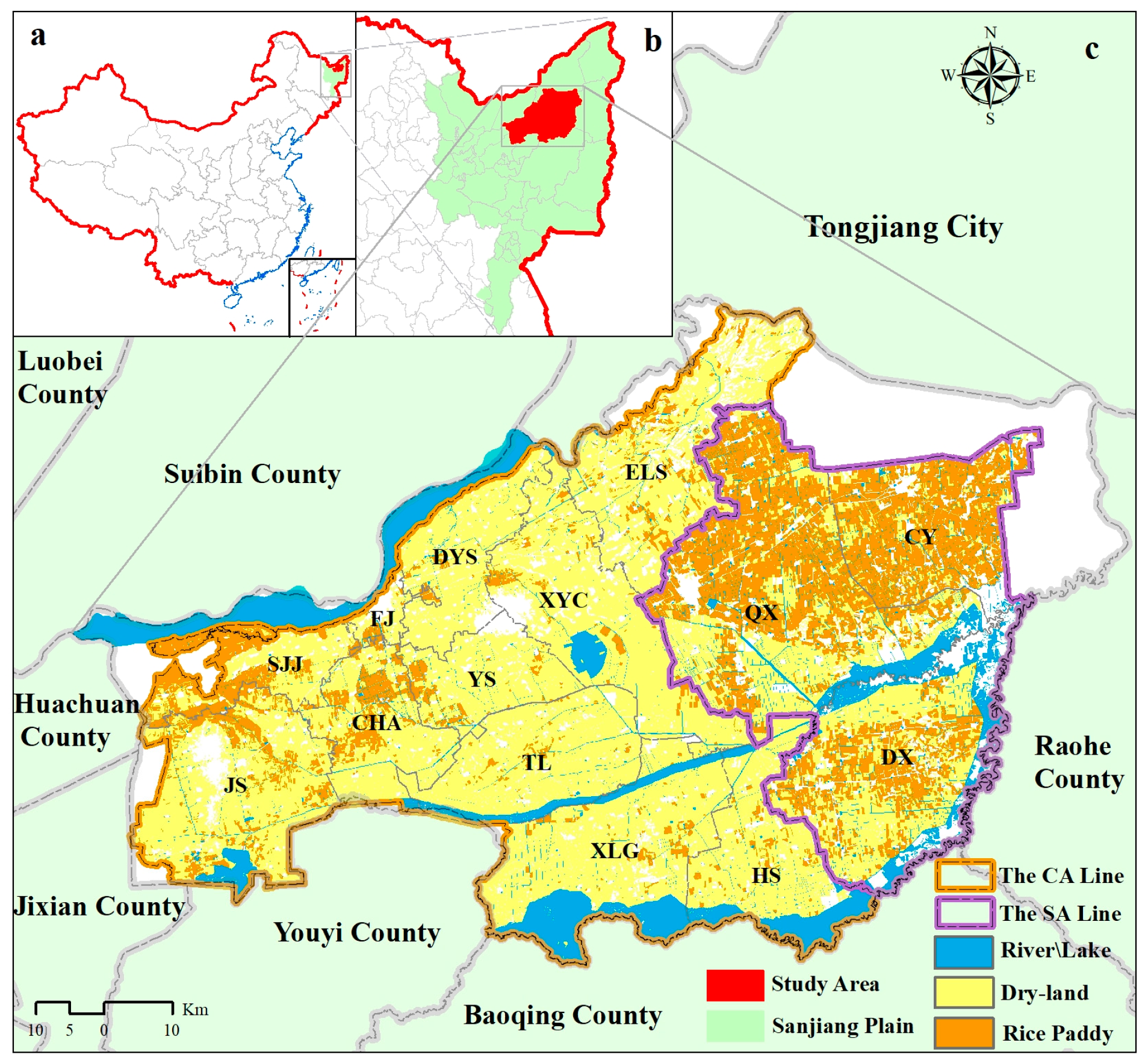
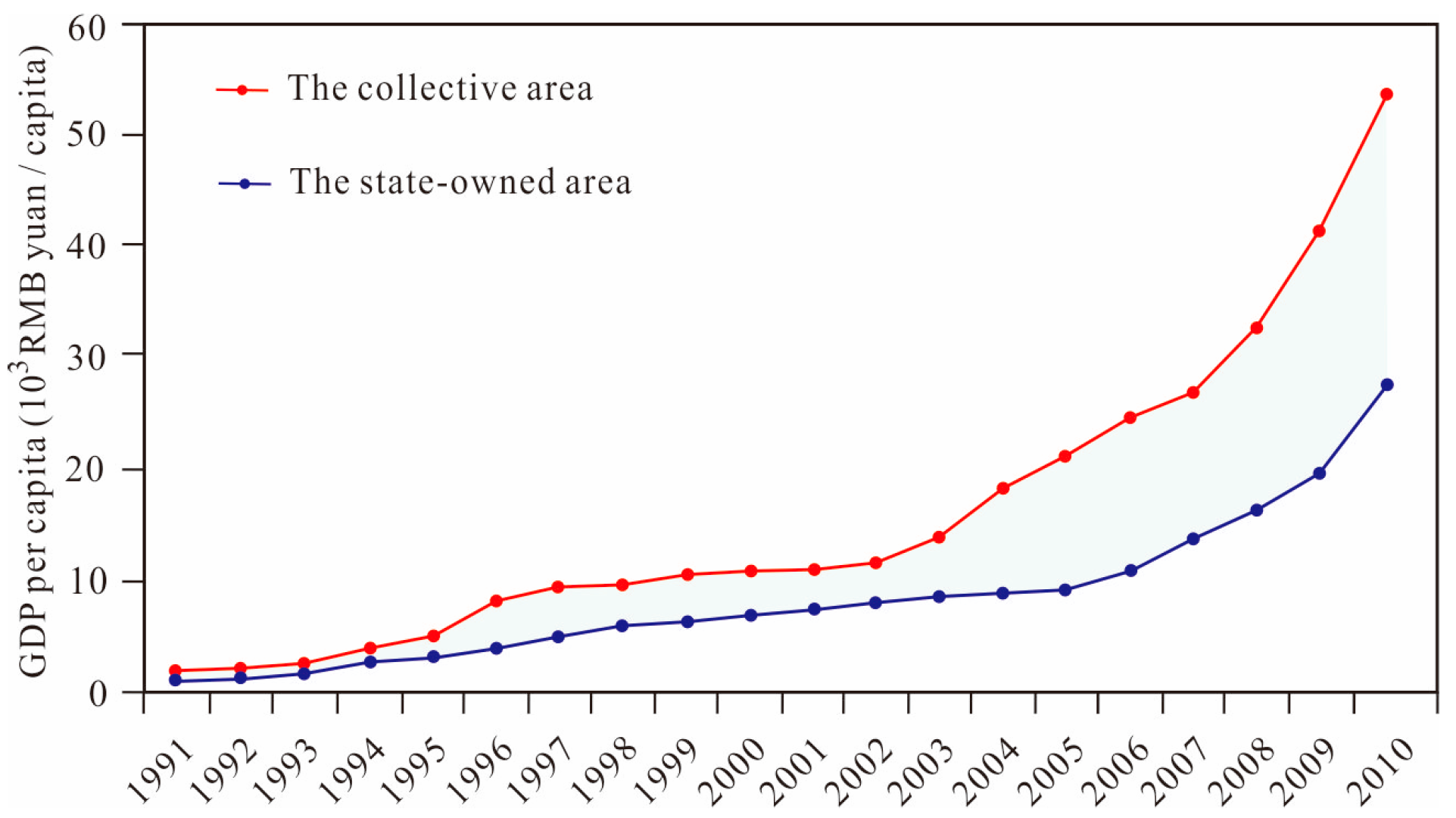
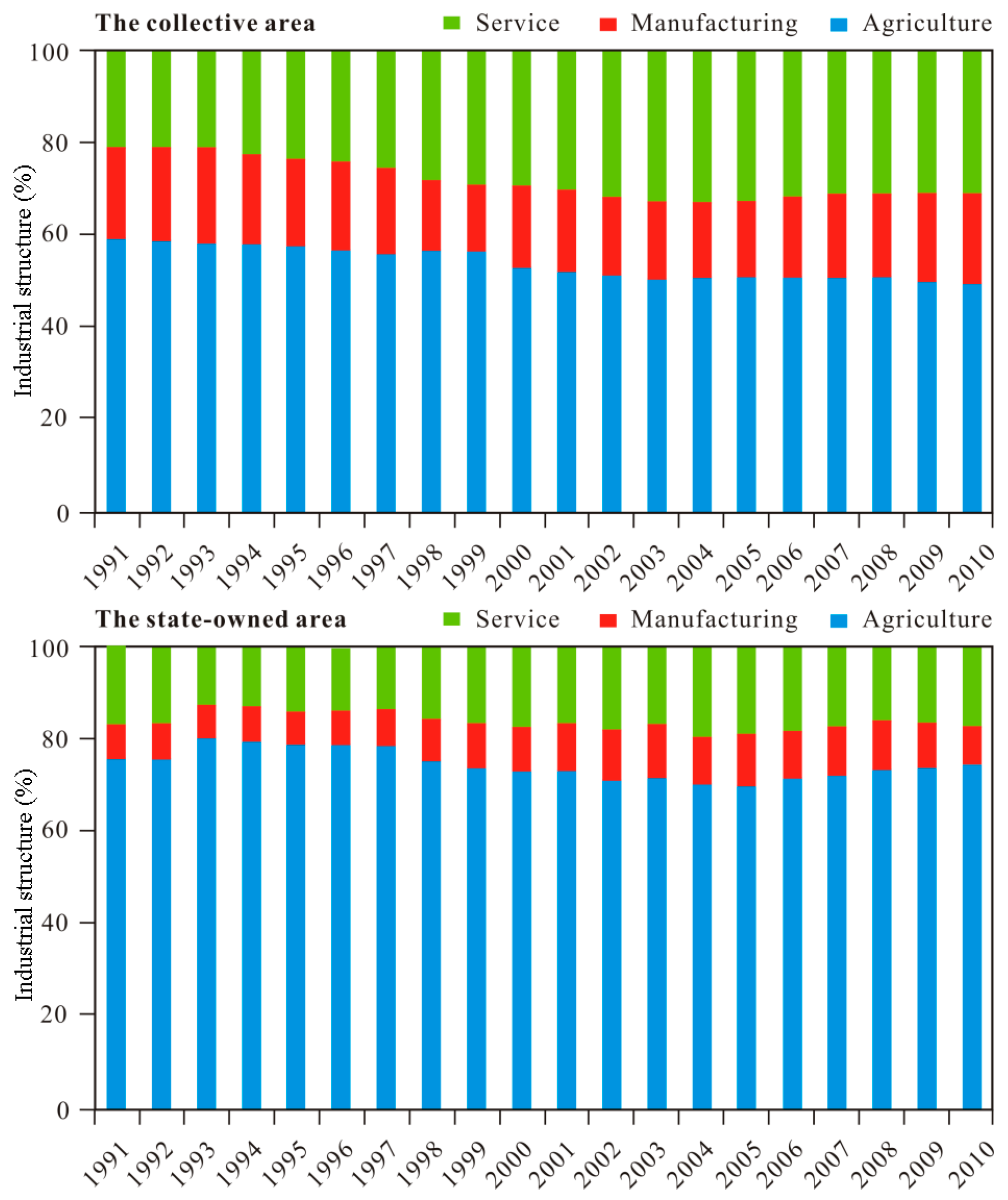
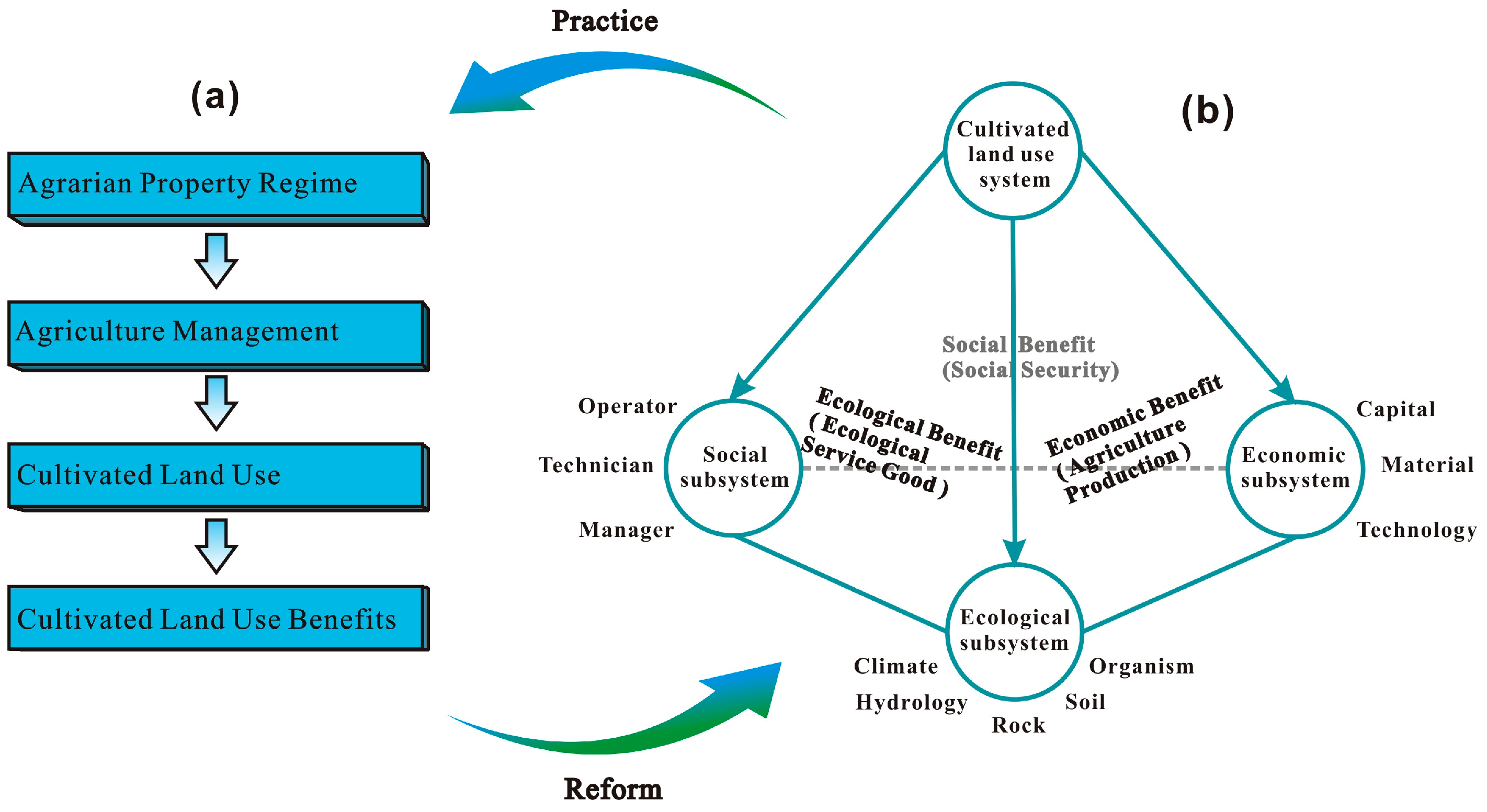
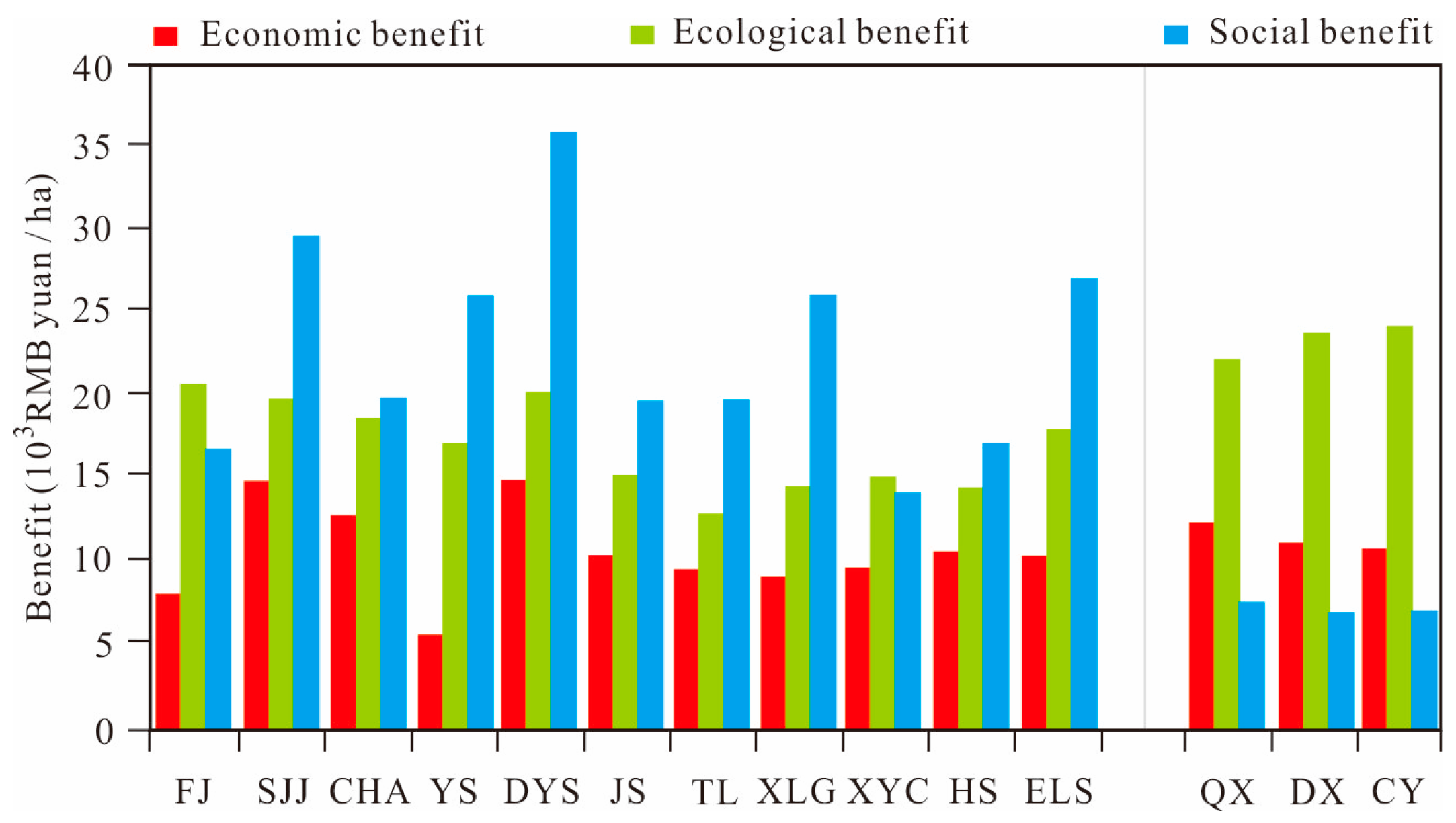
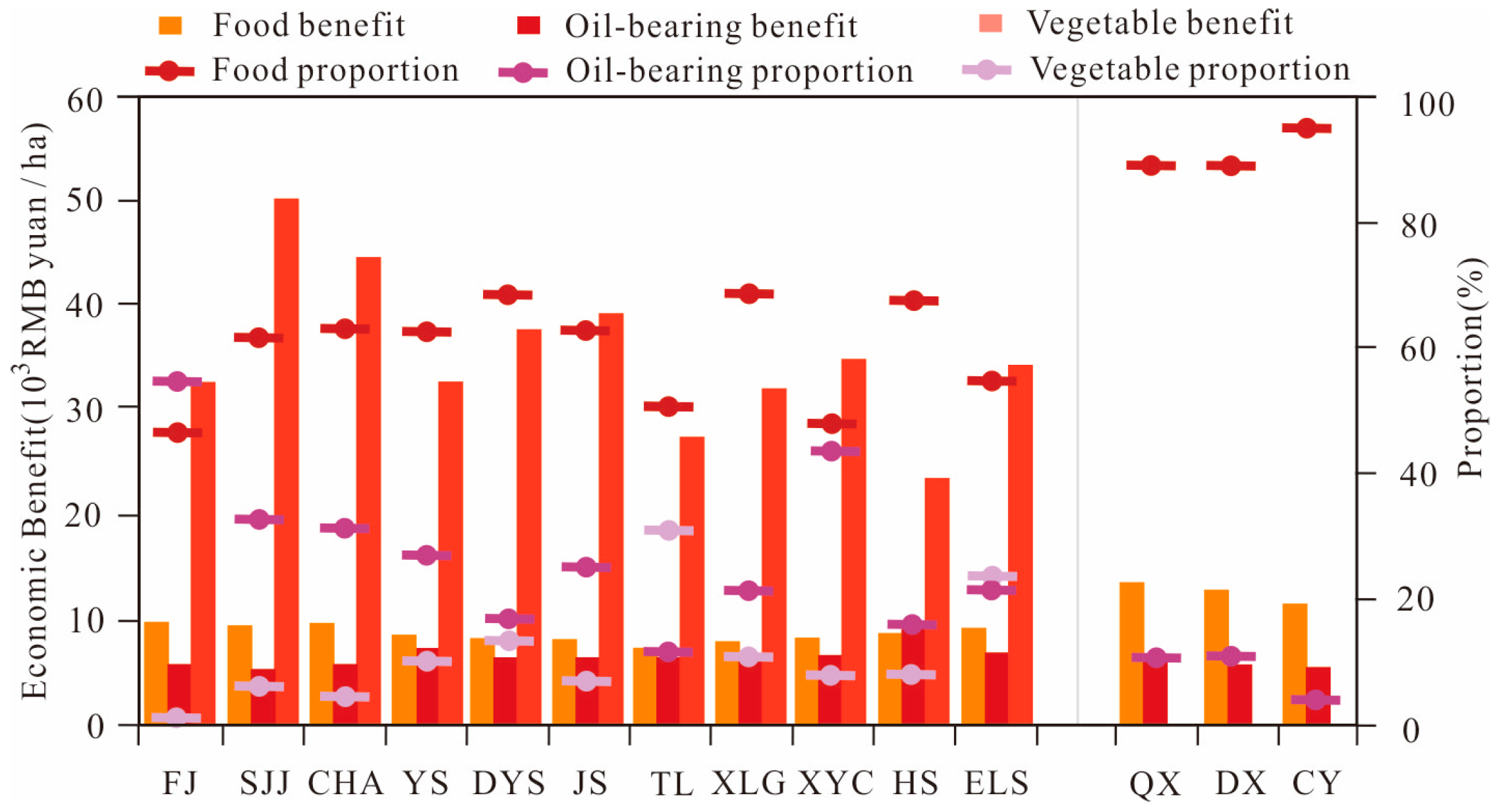
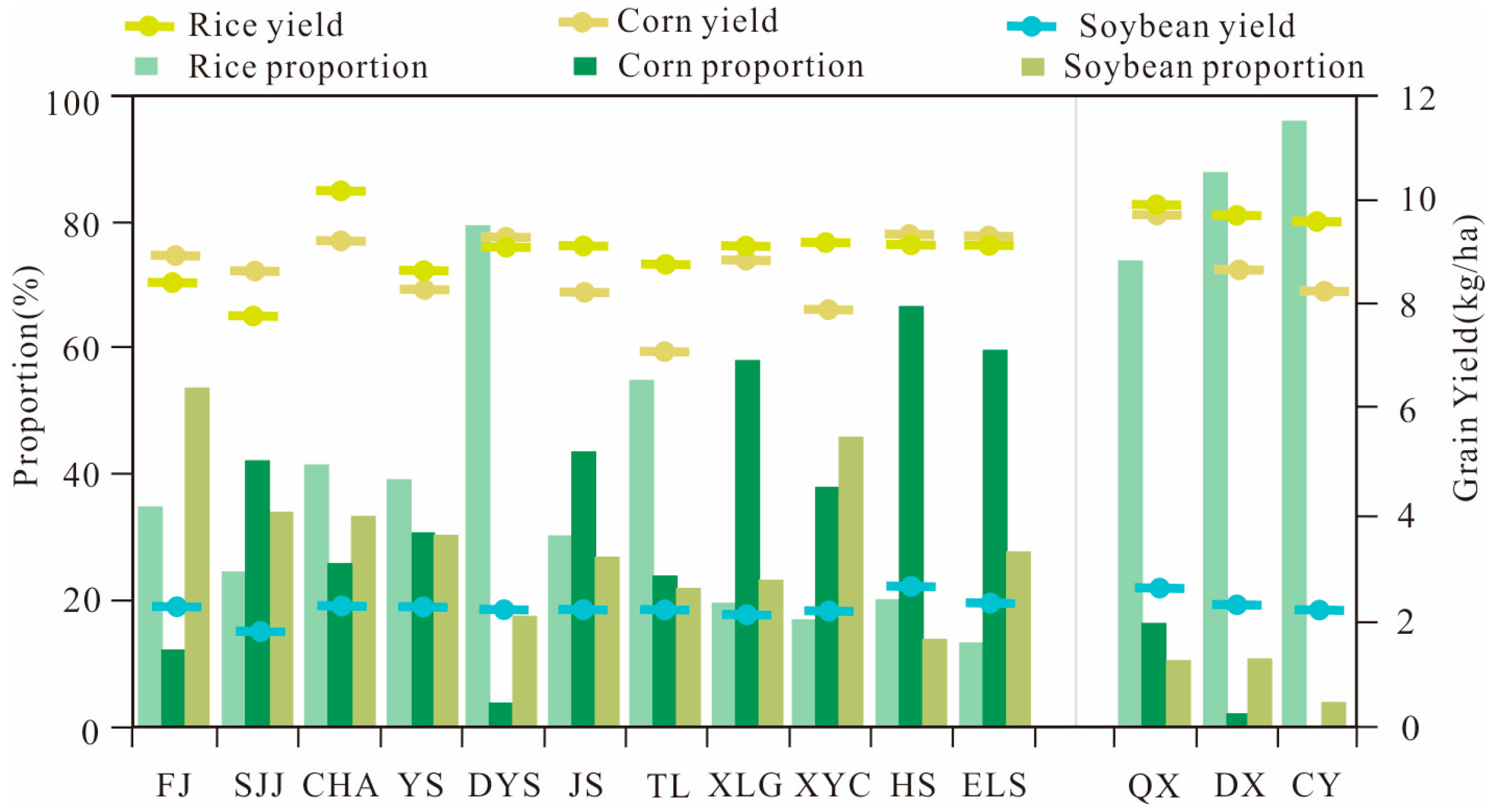
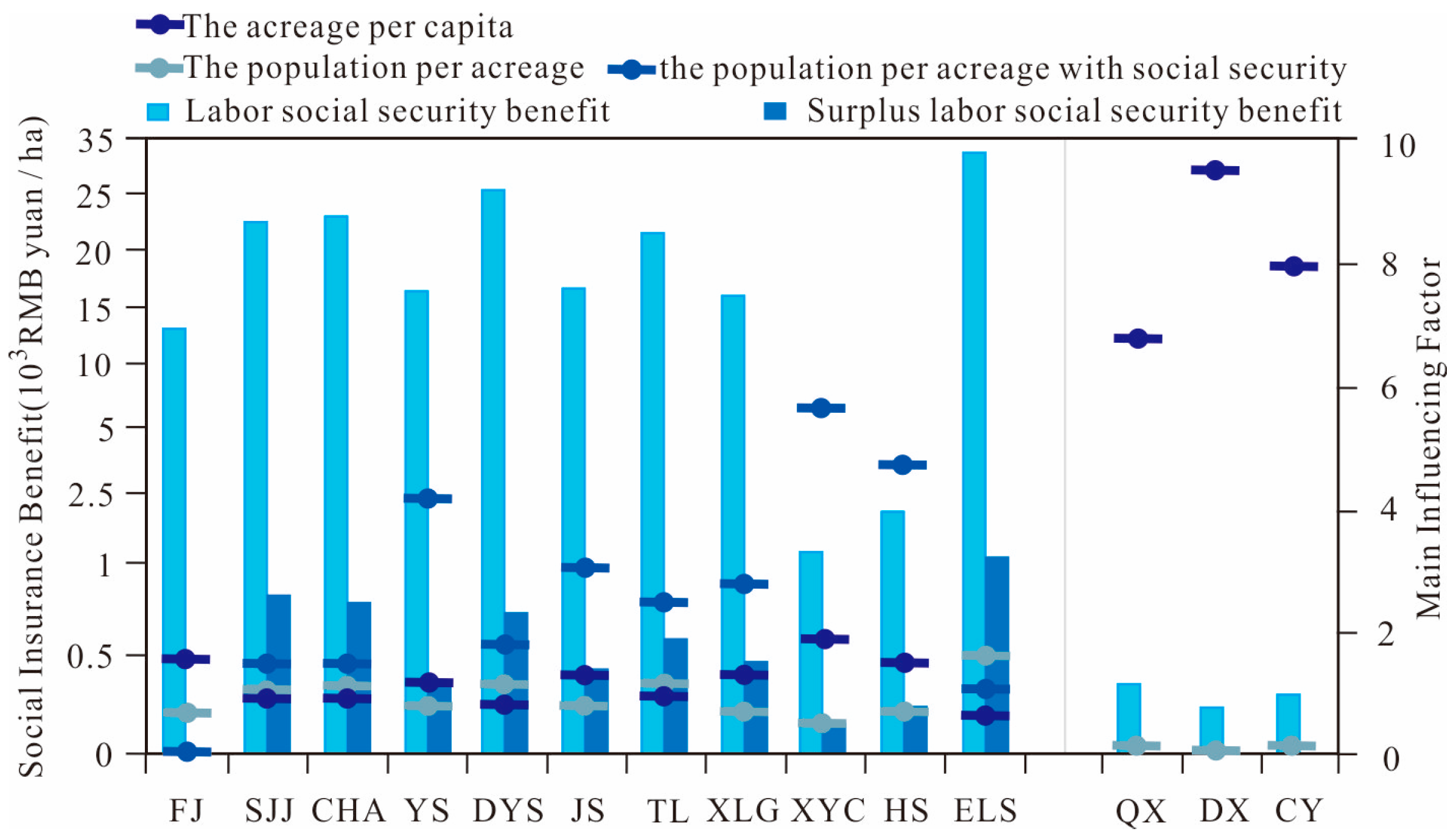

| Target | Status | Factor | Function |
|---|---|---|---|
| The comprehensive benefit of cultivated land use (CB) | Economic benefit (EB) | Food benefit (FB) | Grow food, melon, fruit, vegetables, oil-bearing and other foods |
| Oil-bearing benefit (OB) | |||
| Vegetable benefit (VB) | |||
| Ecological benefit (ECB) | Water conservation benefit (WCB) | Increase water use efficiency and improve water quality | |
| Soil and water conservation benefit (SWB) | Improve soil quality including soil resistance to erosion | ||
| Microclimate improvement benefit (MIB) | Increase air humidity and improve air quality | ||
| Air quality improvement benefit (AQB) | |||
| Biological diversity benefit (BDB) | Facilitate survival and reproduction of species | ||
| Soil sanitation benefit (SSB) | Reduce and eliminate soil pollutants | ||
| Social benefit (SB) | Food security benefit (FSB) | Provide agricultural products and improve social wellbeing | |
| Labor social insurance benefit (LSIB) | Safeguard social stability | ||
| Surplus labor social insurance benefit (SLSIB) | |||
| Entertainment and cultural benefit (ECB) | Improve living quality of the individual and organization |
| Target | Comparison | Status | Comparison | Factor | Comparison | ||||||
|---|---|---|---|---|---|---|---|---|---|---|---|
| CA (RMB Yuan/ha) | SA (RMB Yuan/ha) | Difference (%) | CA (RMB Yuan/ha) | SA (RMB Yuan/ha) | Difference (%) | CA (RMB Yuan/ha) | SA (RMB Yuan/ha) | Difference (%) | |||
| CB | 10,155 | 9650 | −4.97% | EB | 11,306 | 11,966 | 5.84% | FB | 8745 | 11,708 | 33.88% |
| OB | 6761 | 5529 | −18.22% | ||||||||
| VB | 35,639 | 0 | - | ||||||||
| ECB | 16,166 | 22,032 | 36.29% | WCB | 1672 | 2279 | 36.30% | ||||
| SWB | 4069 | 5546 | 36.29% | ||||||||
| MIB | 2481 | 3381 | 36.27% | ||||||||
| AQB | 1394 | 1899 | 36.20% | ||||||||
| BDB | 1979 | 2697 | 36.28% | ||||||||
| SSB | 4571 | 6230 | 36.22% | ||||||||
| SB | 22,961 | 6695 | −70.84% | FSB | 3134 | 4247 | 35.51% | ||||
| SIB | 19,799 | 2410 | −87.83% | ||||||||
| ECB | 28 | 38 | 35.71% | ||||||||
© 2017 by the authors. Licensee MDPI, Basel, Switzerland. This article is an open access article distributed under the terms and conditions of the Creative Commons Attribution (CC BY) license (http://creativecommons.org/licenses/by/4.0/).
Share and Cite
Li, Q.; Hu, S.; Du, G.; Zhang, C.; Liu, Y. Cultivated Land Use Benefits Under State and Collective Agrarian Property Regimes in China. Sustainability 2018, 10, 7. https://doi.org/10.3390/su10010007
Li Q, Hu S, Du G, Zhang C, Liu Y. Cultivated Land Use Benefits Under State and Collective Agrarian Property Regimes in China. Sustainability. 2018; 10(1):7. https://doi.org/10.3390/su10010007
Chicago/Turabian StyleLi, Quanfeng, Shougeng Hu, Guoming Du, Chuanrong Zhang, and Yansui Liu. 2018. "Cultivated Land Use Benefits Under State and Collective Agrarian Property Regimes in China" Sustainability 10, no. 1: 7. https://doi.org/10.3390/su10010007
APA StyleLi, Q., Hu, S., Du, G., Zhang, C., & Liu, Y. (2018). Cultivated Land Use Benefits Under State and Collective Agrarian Property Regimes in China. Sustainability, 10(1), 7. https://doi.org/10.3390/su10010007






